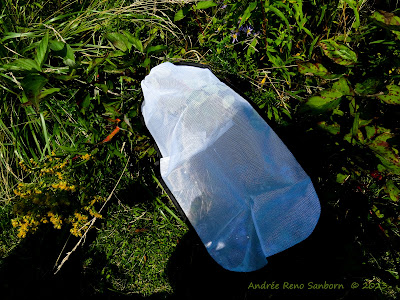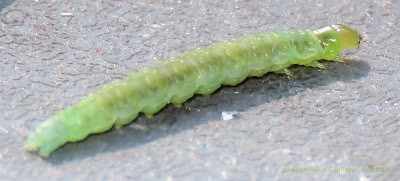 |
| Late season dogwood with rolled leaves. The leaves look old, worn, and well-used by the wildlife, but they are not done with it yet. |
 |
| Peering into a rolled leaf, I found new life. |
 |
| An unidentified moth caterpillar was inside. |
September 2 was the day that Jody and I had a bug hunt here at the house (and found the bear scat). I had found this larva inside a rolled dogwood leaf and thought it was a sawfly. Well, the little buggers confuse me still. It was a moth caterpillar. It could be one of two dogwood moths, both of whose caterpillars look just like this.
When you have identical caterpillars of different species, the only way you can tell which species it is is by isolating it until they pupate into a moth. (Sometimes it is the other way around and identical moths can only be identified, without dissection, by their caterpillars.)
Two days later, Lucy and I went out to sleeve dogwood branches with rolled leaves. The plan is I will regularly check on the creature's growth, hopefully find a newly eclosed moth inside the sleeve, and then be able to identify it.
 |
| A sleeved dogwood branch with rolled leaves inside. |
I buy the sleeves at scientific supply places online. They can breath, drain water, and do not overheat. They keep predators and parasites out and give the animals inside the sleeve relative freedom and safety to feed. Unless you sleeved a predator in the sleeve with your larvae.
Since I really enjoyed spying the larva inside the leaf, I looked inside another rolled leaf before I sleeved the branch and found this . . .
After I turned the photo in the computer, I still did not know what I was looking at. It was sort of like a grasshopper, but those beefy legs hinted at this being a bug that caught and ate other bugs, much like assassin bugs and ambush bugs. Grasshoppers that I know here do not have spotted legs, either. This guy also has a beak, used to pierce the exoskeleton of other insects.
I turned to Jody, who suggested damsel bug (Genus Nabis). I looked it up, and it looks like one to me. No one at iNaturalist has offered any assistance yet, though. It could be winter until I learn what it is. When you have good weather, like we have had, no entomologist, professional or amateur, will be inside the house IDing photos.
If it is a damsel bug, it preys on small caterpillars. And what better place to find them then in their hiding place—a rolled up leaf?
I was sort of pissed off that somebody was out there eating my little caterpillars. Hopefully no predators were on the branch or inside the rolls of my sleeved branch. I have never successfully sleeved a plant until insect maturation. It involves tricky timing and a perfect, predator-free world. We'll see.










.jpg)

.jpg)







%20(1).jpg)
.jpg)
.jpg)
.jpg)
.jpg)
.jpg)
_edited.jpg)

%20(6).jpg)
%20(8).jpg)
%20(3)%202_edited.jpg)
%20(2).jpg)










